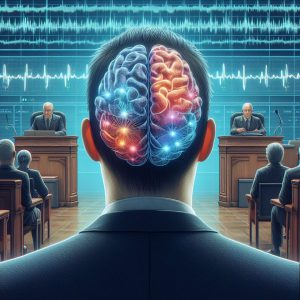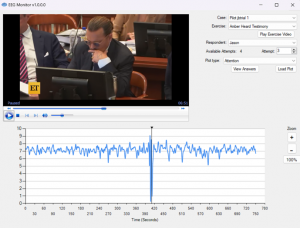
By Lotfi Ben Othmane & Clint Townson
The field of jury consulting has been assailed as non-scientific for decades (Kressel & Kressel, 2002). Even now, the value of consulting is questioned by some at the highest tiers of the legal system (Zoppo, 2023). A big part of the critique has been that consultants claim to be “mind readers” who can glean insights into juror’s decision-making and emotions.
This critique is regarded by most as generally unfair—for one, very few first-rate consultants would describe themselves as mind-readers. Moreover, consultants use myriad scientific techniques to glean useful insights from jurors, from mock trials and focus groups to in-depth community attitude surveys. While these approaches do not encroach upon jurors’ unspoken thoughts—self-report measures tend to be the norm—they adhere to the modern accepted scientific paradigms.
But what if literal “mind reading” is not far off? Consider the following from renown astrophysicist Neil deGrasse Tyson:
“Everything we do, every thought we’ve ever had, is produced by the human brain. But exactly how it operates remains one of the biggest unsolved mysteries, and it seems the more we probe its secrets, the more surprises we find.”
These mysteries are slowly being unwound through advances in neuroscience, and one such advance could revolutionize the trial consulting industry. Never before have jury consultants been able to view the “raw output” of jurors’ thoughts and feelings as they view case materials. But powerful tools to examine the electrical activity in the brain are now becoming accessible and potentially applicable in the field of trial consulting.
An Eight-Syllable Word
Electroencephalogram—better known as EEG—is a technique that is over a century old (Rayi & Murray, 2022). For the majority of that time, neuroscience was chiefly concerned in medical practices for detecting potential brain defects. More contemporary uses have seen it utilized in the growing field of neuropsychology, where EEG is no longer limited to detecting abnormalities but instead unraveling the human decision-making process. Now, scientists are using EEG data to further their understanding of everything from consumer choices (Lin et al., 2018) to performance in sports (Cheron, 2016).
Jury consulting will be the next field to experience an infusion of advancement through EEG. For one, accessing EEG data has become far more accessible and affordable. Whereas collecting brain activity from a research subject used to require a full laboratory set-up, modern solutions enable the collection of EEG data through a simple headset that can be worn by any mock juror. Sophisticated EEG headsets are available on the consumer market for a few hundred dollars from brands like Emotiv and Neurosky—which opens up potential applications for everything from witness testing to graphics evaluations. Imagine a workstation where the juror has a laptop and wears an EEG headset while watching a deposition video or a tutorial for a patent, all while their brain activity—every reaction, every lapse in attention—is being captured in real time. No more “turn dials” which offer a poor and distracting surrogate for the same information: consultants can go straight to the source.
Availability of these data is no longer an obstacle. Many trial consultants have longed to access these kinds of real-time reactions and provide interpretation for their clients. The one missing piece is a bridge between those familiar with evaluating complex neurological data and the consultants who provide guidance to trial attorneys. Unsurprisingly, there are experts now seeking to fill that gap.
Brainiacs on the Brain
The National Science Foundation has funded a company called Brainsoft to develop services that support the intersection of consulting and neuroscientific software. The company conducted extensive research to develop machine learning that connect the raw EEG data with assessments of attention, emotion, and cognitive load, and it is also developing AI-based technology that uses these models for jury consulting. The figure below shows, for example, the trend of the attention of a user while watching courtroom testimony. The technology will enable consultants to apply their valuable knowledge about jurors’ reactions and utilize the information to better assist their clients.

In many ways, this kind of technology might grow to replace self-report measures that have been relied upon for many years by much of the social science world. As noted in Brainsoft founder Dr. Lotfi Ben Othmane’s recent experiment, the technology “provide[s] an objective alternative to the subjective assessment of attention and cognitive load through questionnaires, allowing for more reliable and precise evaluations by circumventing participant biases in self- reported responses.”
This technology is still in its early stages. Brainsoft is refining its technology using pilot programs with consultants—its connections with attitudes, verdict decisions, and even deliberations may be further understood. Brainsoft is also seeking collaborations with the academic community to ground its findings in rigorous and existing social science theory. In this way, it is a cutting-edge technology with significant potential in the field of trial consulting because trial consulting similarly parallels the chasm between the academy and the private sector. As other consultants engage with other neuropschology experts in the field, its utility may be expanded.
Pack the EEG Right Next to the Tablets
The next step in this exciting innovation is for more jury consultants to use the technology for their own practices and projects. As trial consultants become more familiar and adaptable to the technology, attorneys too will seek it out. Every trial lawyer who believes in the value of jury research will gravitate to the newest edge over their opposing counsel—real time brainwaves that have validity that buries the dubious turn dials once and for all.
As the technology continues to develop and pervades the field, it’s possible that the EEG headsets are packed right alongside tablets that are used to collect other measures. Judges and other critics of the trial consulting field have shrugged that practitioners merely pose as mind readers, but with the development of this field, this unfair critique might turn back on them anyway.
Disclosure: Authors hold equity ownership in Brainsoft.
Note: Consultants interested to contribute to the pilots may contact Brainsoft at lbenothmane@brainsofttech.com
References:
Cheron, G., Petit, G., Cheron, J., Leroy, A., Cebolla, A., Cevallos, C., … & Dan, B. (2016). Brain oscillations in sport: toward EEG biomarkers of performance. Frontiers in Psychology, 7, 246.
Kressel, N. J., & Kressel, D. F. (2002). Stack and sway: The new science of jury consulting. Boulder, CO: Westview.
Lin, M. H., Cross, S. N., Jones, W. J., & Childers, T. L. (2018). Applying EEG in consumer neuroscience. European Journal of Marketing, 52(1/2), 66-91.
Rayi, A, & Murray, N. (2022). Electroencephalogram. National Library of Medicine. https://www.ncbi.nlm.nih.gov/books/NBK563295/
Zoppo, A. (2023). Why jury consultants may not be worth it and other tips from judges. Law.com. https://www.law.com/2023/11/10/why-jury-consultants-may-not-be-worth-it-and-other-tips-from-judges/?slreturn=20240029113501